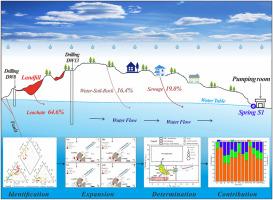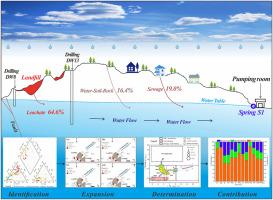岩溶地下水污染综合定量追踪——以贵州省遵义垃圾填埋场为例
IF 7.3
2区 环境科学与生态学
Q1 ENVIRONMENTAL SCIENCES
引用次数: 0
摘要
喀斯特地区突发性地下水污染对饮用水安全构成严重威胁。追踪污染源对于管理和修复地下水污染至关重要。传统的追踪方法往往缺乏准确性,因此本研究结合多种技术对贵州省遵义市城市生活垃圾填埋场附近的污染源进行了追踪和量化。分析显示,83.2%的样品铵、81.5%的样品CODMn和47.9%的样品氯超标,表明污染严重。为了解决这些令人震惊的发现,我们实施了一种全面的方法来更准确地识别和量化污染源。首先,主要元素地球化学示踪确定了主要污染源。其次,微量元素分析提供了更精确的识别,并突出了额外的来源。第三,同位素示踪(δ15N-NO3−,δ18O-NO3−)确定污染源类型和数量。最后,长期水质监测和PMF模型使污染物的定量来源分配成为可能。该综合方法发现,主要污染物是垃圾填埋场渗滤液(64.6%)、生活污水(19.0%)和水-土壤-岩石相互作用的溶质过滤(16.4%)。我们的研究结果表明,结合这些方法可以提高水生环境中的源分辨率精度,并且具有在全球其他喀斯特地区应用的潜力。本文章由计算机程序翻译,如有差异,请以英文原文为准。


Integrated quantitative tracing for Karst groundwater contamination: A case study of landfill in Zunyi, Guizhou Province, China
Sudden groundwater pollution in karst areas poses a serious threat to drinking water safety. Tracing contamination sources is crucial for managing and remediating groundwater pollution. Traditional tracing methods often lack accuracy, so this study combined multiple techniques to trace and quantify pollution sources near the municipal solid waste (MSW) landfill in Zunyi City, Guizhou Province, China. Analysis revealed that 83.2% of samples exceeded Chinese standards for ammonium, 81.5% for CODMn, and 47.9% for chloride, indicating severe pollution. To address these alarming findings, we implemented a comprehensive approach to identify and quantify the sources of contamination more accurately. First, major element geochemical tracing identified primary contamination sources. Second, trace element analysis provided more precise identification and highlighted additional sources. Third, isotopic tracing (δ15N-NO3−, δ18O-NO3−) determined types and quantities of pollution sources. Finally, long-term water quality monitoring and the PMF model enabled quantitative source apportionment of pollutants. This integrated approach found that the primary pollutants were landfill leachate (64.6%), domestic sewage (19.0%), and solute filtration from water-soil-rock interactions (16.4%). Our findings demonstrate that combining these methods enhances source resolution accuracy in aquatic environments and has the potential to be utilized in other karst regions worldwide.
求助全文
通过发布文献求助,成功后即可免费获取论文全文。
去求助
来源期刊

Environmental Pollution
环境科学-环境科学
CiteScore
16.00
自引率
6.70%
发文量
2082
审稿时长
2.9 months
期刊介绍:
Environmental Pollution is an international peer-reviewed journal that publishes high-quality research papers and review articles covering all aspects of environmental pollution and its impacts on ecosystems and human health.
Subject areas include, but are not limited to:
• Sources and occurrences of pollutants that are clearly defined and measured in environmental compartments, food and food-related items, and human bodies;
• Interlinks between contaminant exposure and biological, ecological, and human health effects, including those of climate change;
• Contaminants of emerging concerns (including but not limited to antibiotic resistant microorganisms or genes, microplastics/nanoplastics, electronic wastes, light, and noise) and/or their biological, ecological, or human health effects;
• Laboratory and field studies on the remediation/mitigation of environmental pollution via new techniques and with clear links to biological, ecological, or human health effects;
• Modeling of pollution processes, patterns, or trends that is of clear environmental and/or human health interest;
• New techniques that measure and examine environmental occurrences, transport, behavior, and effects of pollutants within the environment or the laboratory, provided that they can be clearly used to address problems within regional or global environmental compartments.
 求助内容:
求助内容: 应助结果提醒方式:
应助结果提醒方式:


